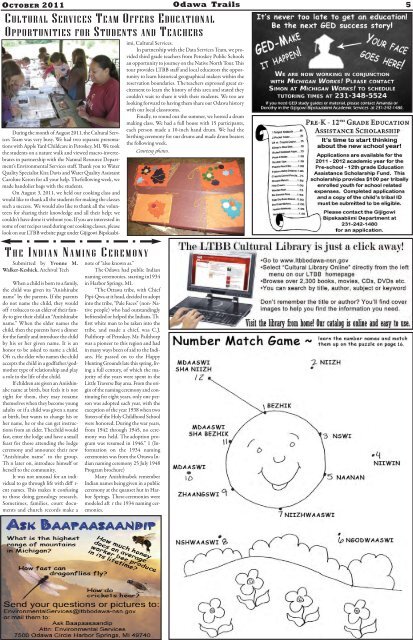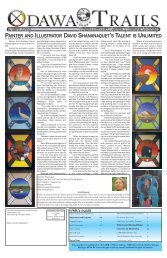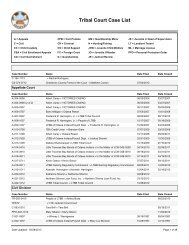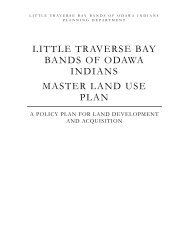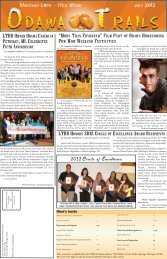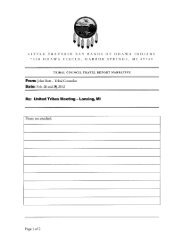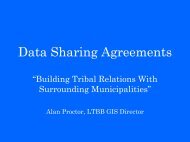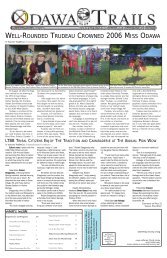October - Little Traverse Bay Bands of Odawa Indians
October - Little Traverse Bay Bands of Odawa Indians
October - Little Traverse Bay Bands of Odawa Indians
Create successful ePaper yourself
Turn your PDF publications into a flip-book with our unique Google optimized e-Paper software.
<strong>Odawa</strong> Trails<br />
OCTOBER 2011 5<br />
CULTURAL SERVICES TEAM OFFERS EDUCATIONAL<br />
OPPORTUNITIES FOR STUDENTS AND TEACHERS<br />
During the month <strong>of</strong> August 2011, the Cultural Services<br />
Team was very busy. We had two separate presentations<br />
with Apple Yard Childcare in Petoskey, MI. We took<br />
the students on a nature walk and viewed macro-invertebrates<br />
in partnership with the Natural Resource Department’s<br />
Environmental Services staff. Thank you to Water<br />
Quality Specialist Kira Davis and Water Quality Assistant<br />
Caroline Keson for all your help. Thefollowing week, we<br />
made bandolier bags with the students.<br />
On August 3, 2011, we held our cooking class and<br />
would like to thank all the students for making the classes<br />
such a success. We would also like to thank all the volunteers<br />
for sharing their knowledge and all their help; we<br />
couldn’t have done it without you. If you are interested in<br />
some <strong>of</strong> our recipes used during our cooking classes, please<br />
look on our LTBB website page under Gijigowi Bipskaabi-<br />
T HE I NDIAN N AMING C EREMONY<br />
Submitted by Yvonne M.<br />
Walker-Keshick, Archival Tech<br />
When a child is born to a family,<br />
the child was given its “Anishinabe<br />
name” by the parents. If the parents<br />
do not name the child, they would<br />
<strong>of</strong>f r tobacco to an elder <strong>of</strong> their family<br />
to give their child an “Aniishinabe<br />
name.” When the elder names the<br />
child, then the parents have a dinner<br />
for the family and introduce the child<br />
by his or her given name. It is an<br />
honor to be asked to name a child.<br />
Oft n, the elder who names the child<br />
accepts the child in a godfather/godmother<br />
type <strong>of</strong> relationship and play<br />
a role in the life <strong>of</strong> the child.<br />
If children are given an Aniishinabe<br />
name at birth, but feels it is not<br />
right for them, they may rename<br />
themselves when they become young<br />
adults or if a child was given a name<br />
at birth, but wants to change his or<br />
her name, he or she can get instructions<br />
from an elder. Thechild would<br />
fast, enter the lodge and have a small<br />
feast for those attending the lodge<br />
ceremony and announce their new<br />
“Anishinabe name” to the group.<br />
Th n later on, introduce himself or<br />
herself to the community.<br />
It was not unusual for an individual<br />
to go through life with diff rent<br />
names. This makes it confusing<br />
to those doing genealogy research.<br />
Sometimes, families, court documents<br />
and church records make a<br />
note <strong>of</strong> “also known as.”<br />
The <strong>Odawa</strong> had public Indian<br />
naming ceremonies, starting in1934<br />
in Harbor Springs, MI.<br />
“The Ottawa tribe, with Chief<br />
Pipi-Qwa at it head, decided to adopt<br />
into the tribe, “Pale Faces” (non- Native<br />
people) who had outstandingly<br />
befriended or helped the <strong>Indians</strong>. Th<br />
first white man to be taken into the<br />
tribe, and made a chief, was C.J.<br />
Pailthorp <strong>of</strong> Petoskey. Mr. Pailthorp<br />
was a pioneer to this region and had<br />
in many ways been <strong>of</strong> aid to the <strong>Indians</strong>.<br />
He passed on to the Happy<br />
Hunting Grounds late this spring, living<br />
a full century, <strong>of</strong> which the majority<br />
<strong>of</strong> the years were spent in the<br />
<strong>Little</strong> <strong>Traverse</strong> <strong>Bay</strong> area. From the origin<br />
<strong>of</strong> the naming ceremony and continuing<br />
for eight years, only one person<br />
was adopted each year, with the<br />
exception <strong>of</strong> the year 1938 when two<br />
Sisters <strong>of</strong> the Holy Childhood School<br />
were honored. During the war years,<br />
from 1942 through 1945, no ceremony<br />
was held. The adoption program<br />
was resumed in 1946.” 1 (Information<br />
on the 1934 naming<br />
ceremonies was from the Ottawa Indian<br />
naming ceremony 25 July 1948<br />
Program brochure)<br />
Many Anishiinabek remember<br />
Indian names being given in a public<br />
ceremony at the quanset hut in Harbor<br />
Springs. These ceremonies were<br />
modeled aft r the 1934 naming ceremonies.<br />
imi, Cultural Services.<br />
In partnership with the Data Services Team, we provided<br />
third grade teachers from Petoskey Public Schools<br />
an opportunity to journey on the Native North Tour. This<br />
tour provides LTBB staff and local educators the opportunity<br />
to learn historical geographical makers within the<br />
reservation boundaries. The teachers expressed great excitement<br />
to learn the history <strong>of</strong> this area and stated they<br />
couldn’t wait to share it with their students. We too are<br />
looking forward to having them share our <strong>Odawa</strong> history<br />
with our local classrooms.<br />
Finally, to round out the summer, we hosted a drum<br />
making class. We had a full house with 15 participants,<br />
each person made a 10-inch hand drum. We had the<br />
birthing ceremony for our drums and made drum beaters<br />
the following week.<br />
Courtesy photos.<br />
16.


